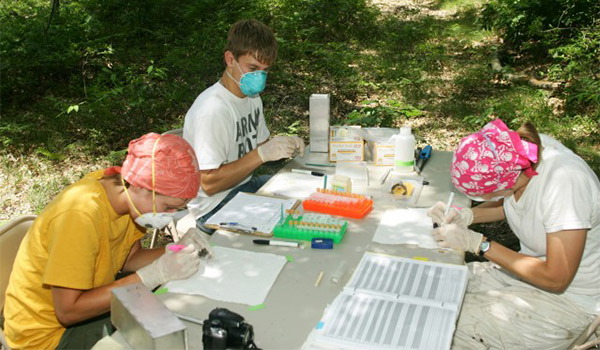
Ask the Flight Surgeon / By MAJ (Dr.) Sarah B. Snyder: Q: I enjoy recreational hiking and camping outdoors during the spring and summer months but recently heard about a tick-borne illness called Lyme disease. What is Lyme disease and what are the common signs and symptoms to watch out for after spending time outdoors?
FS: Lyme disease is a bacterial infection of the blood, or bacteremia, transmitted to humans by the bite of a deer tick called Ixodes scapularis. It is the most common vector-borne disease in the United States. Lyme disease is caused by the mobile, corkscrewed bacteria Borrelia burgdorferi with the ability to spread systemically throughout the body. According to the Centers for Disease Control and Prevention (CDC), it is estimated that there are approximately 300,000 cases of Lyme disease annually in the United States. Most cases of Lyme disease occur on the east coast of the country, but a species of tick on the west coast, Ixodes pacificus, can also spread the infection. There have also been reported cases of the disease in other regions of the country, such as in southern and mid-western states. Oftentimes, a Soldier will not notice the site of a tick bite because the culprit may be a small, immature tick called a nymph, only a millimeter in size. To transmit Lyme disease, a tick will normally have to be attached for a period of 36 hours or greater to its host. Soldiers and Aviators who spend time recreationally hiking, camping, or with military units in the field may be at a higher risk for environmental exposure to ticks, and, therefore, Lyme disease.

Clockwise from bottom left: Lydia Kramer, an undergraduate student at Michigan State University; Marty Williamson, a volunteer from UW-River Falls; and Isis Kuczaj, a graduate student from Michigan State University, check for ticks on mice/voles at a… (Photo Credit: U.S. Army)
In the early stages of Lyme disease, most infected individuals will develop a rash that resembles the shape of a bull’s eye target, termed Erythema migrans. However, it is estimated that approximately 20-30% of individuals will not develop the bull’s eye rash clinically diagnostic for the infection. Some patients may only develop swelling, warmth, and redness of a joint in the area where a tick attached to the skin. In the initial phases of untreated Lyme disease, Soldiers may develop a constellation of vague, nonspecific flu-like symptoms a few weeks after the bite of a tick. These symptoms may include fatigue, depression, body aches, joint aches, headaches, facial droop, and fevers. Due to the motile nature of the bacteria, in severe or chronic cases of infection there may be joint, cardiac, or nervous system involvement. In chronic Lyme disease, cardiac complications may occur such as third-degree heart block, causing abnormal beating of the heart. A deer tick bite may also carry other bacterial illnesses such as Babesiosis or Ehrlichiosis, which may concurrently cause co-infection with Lyme disease.
If you suspect that you may have the signs or symptoms of Lyme disease after a recreational trip in the woods or from an occupational exposure in the field, see your primary care physician who may order a laboratory test to detect Lyme antibodies in your blood. Generally, a screening Lyme ELISA (enzyme-linked immunosorbent assay) test will detect these serum antibodies. If the ELISA test is positive or equivocal, a confirmatory test called a Western Blot will be performed. Outpatient treatment for uncomplicated cases of Lyme disease will generally consist of a two to three weeks course of oral doxycycline (an antibiotic). If you remove a tick that you suspect has only been attached for a few hours, the CDC does not recommend taking antibiotics prophylactically to prevent tick-borne disease. In terms of flight status, uncomplicated early cases of Lyme disease treated with antibiotics are not disqualifying for flight status. Cases of Lyme disease that have gone undetected for months with the development of chronic complications, such as symptomatic cardiac or neurological involvement, could potentially be disqualifying for flight.
Before hiking or camping outdoors it is recommended to treat all clothing and gear with 0.5% permethrin or to use Environmental Protection Agency (EPA) approved insect repellants, such as Oil of Lemon Eucalyptus, DEET, or picaridin. After outdoor activities, be sure to examine your body and clothing for ticks. If you find a tick attached to your skin, remove it as soon as possible with fine-tipped tweezers in order to avoid crushing it with your fingers. Grasp the tick as close as possible to the skin surface and pull the head of the tick straight back, avoiding all twisting motions. Additionally, you may want to save the tick for identification later with your healthcare provider. Lyme is a reportable infectious disease and all cases should be reported to the local state health department.
Questions for the Flight Surgeon?
If you have a question you would like addressed, email it to This email address is being protected from spambots. You need JavaScript enabled to view it.; we will try to address it in the future. See your unit flight surgeon for your personal health issues. The views and opinions offered are those of the author and researchers and should not be construed as an official Department of the Army position unless otherwise stated.
MAJ (Dr.) Sarah B. Snyder, D.O., MPH, FS is a flight surgeon at the School of Army Aviation Medicine, Fort Rucker, Alabama.








